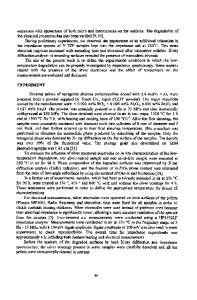Factors influencing the stability of the tetragonal form of zirconia
- PDF / 535,177 Bytes
- 6 Pages / 594 x 810 pts Page_size
- 37 Downloads / 318 Views
Burton H. Davis Kentucky Center for Energy Research Laboratory, University of Louisville, P. 0.Box 1301.5, Lexington, Kentucky 4OS12 (Received 29 January 1986; accepted 6 June 1986)
The pH of the solution that zirconia is precipitated from defines the crystal phase formed after calcination of the material at 400 ’to 600 “C. A metastable tetragonal form is obtained for either low (less than about 5) or high (greater than about 13) pH. The tetragonal phase formed at highpH is much more stable at the calcination temperature than the material obtained at a lowpH is. For a material obtained by precipitation at a low pH, monoclinic crystallites, determined by x-ray line broadening, were obtained that were smaller than the tetragonal crystals that produced them. A crystallite size effect, based on x-ray line broadening, is not responsible for the formation or stabilization of the tetragonal phase.
1. INTRODUCTION Zirconia is an important ceramic material. It is used in a number of applications where unique properties provide advantages; included among these are materials with improved mechanical properties as a result of transformation toughening in ZrO,; solid electrolyte, where superior ionic conduction by oxygen ions leads to many applications; and as a catalytic material or support with unique properties. An important feature of the material is the metastable low-temperature phase transformation of the oxide where the tetragonal phase can be transformed to a more stable monoclinic phase. Several explanations for the stabilization have been advanced but it still remains controversial. G a r ~ i e ’ - ~attributes the metastable tetragonal phase stability to a lower surface energy for the tetragonal phase than for the monoclinic phase. Garvie estimates the critical size for stabilization of the tetragonal phase, based on surface stabilization energy, to be about 300 A. Thus, crystallitessmaller than about 300 A could exist as the less stable tetragonal form but that particles larger than about 300 A would transform to the more stable monoclinic form. Bailey et al.4 observed a progressive monoclinic-to-tetragonal transformation of zirconia with increasing time as ball-milling decreased the particle size. Murase and Kato5 found that water vapor increases the rate of crystal growth and reduces the critical size for transformation. Morgan,6 on the basis of both his and Clarfield’s’ observation of monoclinic crystals smaller than ca. 300 A, the critical size calculated by Garvie, questioned whether surface energy factors inhibit the t-+m transformation. However, Garvie’s size estimate was based upon several assumptions; thus, the concept of surface energy stabilization of t-ZrO, should not be considered J. Mater. Res. 1 (4), Jul/Aug 1986 http://journals.cambridge.org
proven, or disproven, on the basis of a single crystal size. A second explanation depends upon the structural similarity between the precursor and crystalline t-ZrO, rather than upon the particle size effect outlined above. For example, Livage et aL8 attribute
Data Loading...











